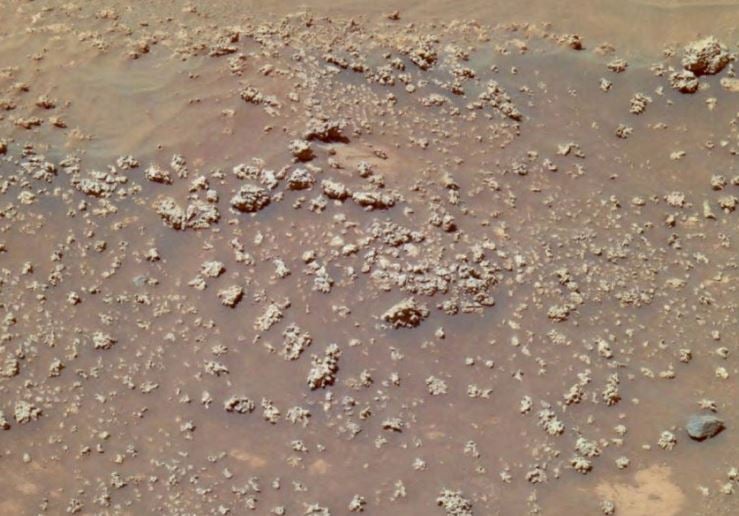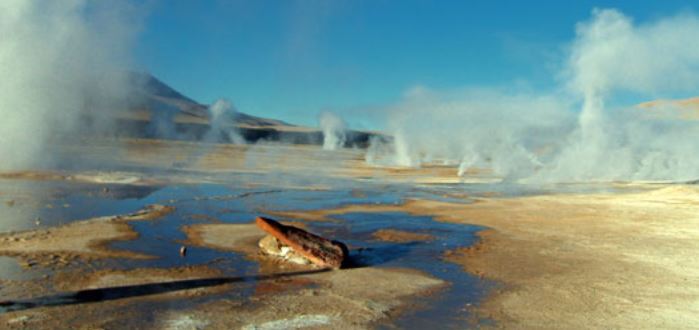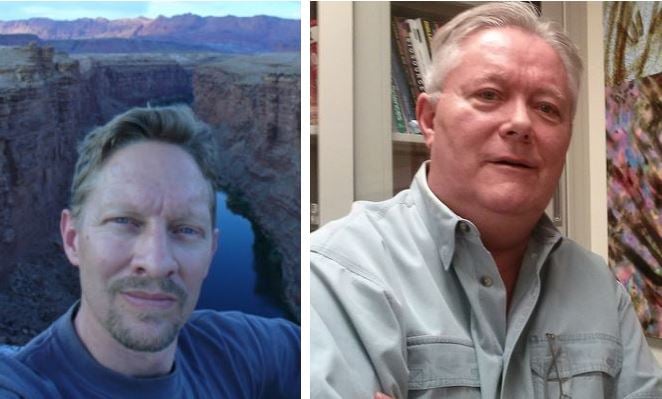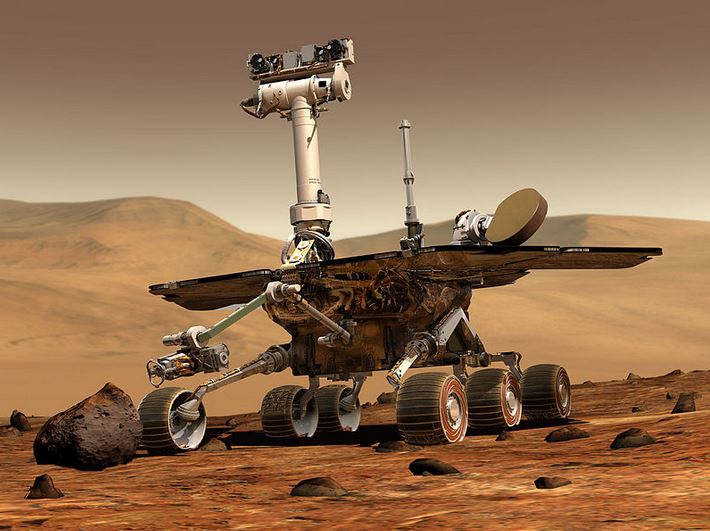Martian microbes could well have shaped cauliflower like minerals, say two scientists, after examining data sent by NASA’s Spirit rover from inside a crater that once probably had geysers and hot springs. Is this proof, at last, that Mars did once have life as we know it?
Scientists have been hunting for life on Mars for several decades, and until this latest find, all the specimens were lifeless samples of either rocks or dust. Over the past couple of years data has been accumulating that Mars probably had large oceans billions of years ago – but life … nothing, until now.
 Could these cauliflower-shaped silica formations have been sculpted by ancient Martian microbes? (Image: NASA/Caltech)
Could these cauliflower-shaped silica formations have been sculpted by ancient Martian microbes? (Image: NASA/Caltech)
The Martian life clue we’ve been waiting for?
Professor Jack Farmer, of the School of Earth and Space Exploration, and Associate Research Professor Steven Ruff, of the Mars Space Flight Facility Faculty, both part of Arizona State University, believe that the unusually-shaped minerals could be the clue we have all been waiting for.
NASA announced in 2008 that its Spirit rover had discovered opaline silica deposits within the Gusey crater. The silica’s outer layers are covered in very small nodules that look like cauliflower heads sprouting from the red soil.
The two scientists base their conclusions that the cauliflower shapes were sculpted by microbes on recent discoveries in a super-arid Chilean desert. They presented their findings at a meeting of the American Geophysical Union in December 2015 (citation bottom of page).
Sarah Soles wrote in the Smithsonian Magazine that the silica cauliflower theory could well go down in history as the greatest discovery ever in astronomy, that is, if the two scientists’ theory is verified.
First find a Martian-like place on Earth
Proving biological hypotheses has never been easy, and doing so from millions of miles away will be extremely difficult for Professors Farmer and Ruff.
They believe these mysterious growths could well be linked to alien life forms, and should be investigated further.
The Mars rover found the so called micro-digitate silica protrusions in the Gusev crater, near the ‘Home Plate’ region. Astrogeologists believe that area once had hot springs and geysers.
 El Tatio geysers. The name comes from the Qechua word for ‘oven’. If microbes thrive there, could Martian microbes existed once if the environment was similar? (Image: gochile.cl)
El Tatio geysers. The name comes from the Qechua word for ‘oven’. If microbes thrive there, could Martian microbes existed once if the environment was similar? (Image: gochile.cl)
In order to get a better understanding what that area used to be like, we need to study the hydrothermal regions today on Earth.
Prof. Ruff visited the Atacama Desert in Chile – a high-plateau west of the Andes mountain range known as the driest (non-polar) place on Earth. The Atacama is often compared to Mars by scientists – its extreme desert climate and soil are the nearest things we have here to the Red Planet.
The part of the desert Prof. Ruff went to gets less than 100 millimetres of rain annually, while its temperature plummets to -13°F (-25°C) and shoots up to 113°F (45°C). The plateau is 13,000 feet above sea level, meaning the air is thin so more ultraviolet (UV) radiation hits the ground – Mars’ atmosphere is thin and its surface is struck by much higher levels of UV radiation than Earth’s surface.
Clearly, the Atacama with its desert foxes, Darwin’s leaf-eared mice, scorpions, lizards, several species of birds, and other creatures is definitely not Mars. However, it is probably as close as we can get to what the Red Planet’s environment may have been like a long time ago, when it was warmer and wetter.
Home Plate on Mars and El Tatio on Earth
To get an understanding of Home Plate, Prof. Ruff went to El Tatio, an area in the Atacama full of geysers – eighty of them. Most mammals, reptiles and other creatures would not be able to survive there, except for microbes – they thrive there now, and according to fossil evidence, have done so for a very long time.
The two scientists say it would be fair to infer that Mars’ Home Plate was probably once an environment – with its geysers and hot springs – where microbes could have survived.
Prof. Ruff also noticed that some of the silica formations he observed at El Tatio were amazingly similar to those encountered by the Mars Spirit rover. Fraternal cauliflower twins can also be found at the Taupo Volcanic Zone in New Zealand and Yellowstone National Park in Wyoming. In both of those places, there is fossil evidence of microbial life.
 Professors Steven Ruff (left) and Jack Farmer.
Professors Steven Ruff (left) and Jack Farmer.
So, we know that microbes sculpted the silica shapes in New Zealand and Wyoming. They may also have done the same at El Tatio. If microbes contributed to the cauliflower formations at El Tatio, perhaps the same happened in Mars as well.
Looking biological does not mean it is
However, you cannot always make assumptions about one part of Earth by extrapolating data gleaned from another part, it isn’t as simple as that, and historically we know that the conclusions are not always accurate.
Doing the same from areas of one planet and assuming the something similar happened in another world millions of miles away, where no signs of life have yet been found, is tenuous to say the least!
The Smithsonian quoted Dr. Kurt Konhauser, of the University of Alberta’s Department of Earth and Atmospheric Sciences, who is also the editor-in-chief of the journal Geobiology, as saying:
“Having worked on modern hot springs, I have seen all forms of structures that look biological but are not. Because it looks biological doesn’t mean it is”
 An artistic view of the Mars Spirit Rover, also known as MER-A or MER-2. It is a robotic rover on Mars that was active from 2004 to 2010. (Image: Wikipedia)
An artistic view of the Mars Spirit Rover, also known as MER-A or MER-2. It is a robotic rover on Mars that was active from 2004 to 2010. (Image: Wikipedia)
Silica is known to have many complex structures which are not linked to biological processes.
Although professors Farmer and Ruff are clearly excited about what they have found and believe there is a good chance that microbes were involved in creating the cauliflower formations on Mars, for the moment they are just saying that the silica protrusions warrant further study.
Spirit stopped its scientific roving five years ago. NASA says its Mars 2020 rover will be launched in a few years and will be bringing samples back to Earth. Perhaps the two scientists’ presentation in December may convince NASA to include the Gusev crater in its list ‘must-visit’ areas.
Professors Ruff and Farmer say they will do more digging here on Earth while they wait for additional data from Mars.
They want to conclusively rule out or confirm the involvement of microbes in El Tatio’s silica structures. If they are found to be microbe-related, the scientists will probably feel they are that little bit closer to getting more people excited at the prospect of Martian life, albeit a long time ago.
Citation: “Micro-digitate Silica Structures on Earth and Mars: Potential Biosignatures Revealed in the Geyser Field of El Tatio, Chile (Invited),” Steven Ruff and Jack Farmer. AGU Fall Meeting, San Francisco, 15 Dec 2015. P23A-01.
Video – The Mars Rovers
In this video, NASA engineer Kobie Boykins, who helped design the Mars rovers Curiosity, Opportunity and Spirit, explains what these robots are telling us about the existence of life on the Red Planet.
